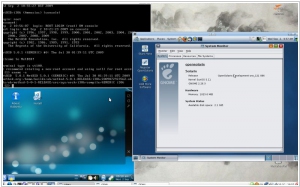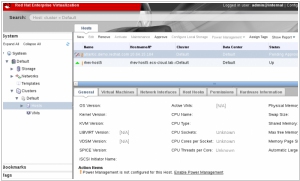KVM vs Red Hat Virtualization
July 25, 2023 | Author: Michael Stromann
16

KVM (for Kernel-based Virtual Machine) is a full virtualization solution for Linux on x86 hardware containing virtualization extensions (Intel VT or AMD-V). It consists of a loadable kernel module, kvm.ko, that provides the core virtualization infrastructure and a processor specific module, kvm-intel.ko or kvm-amd.ko. KVM also requires a modified QEMU although work is underway to get the required changes upstream.
7

Red Hat Virtualization is an open, software-defined platform that virtualizes Linux and Microsoft Windows workloads. Built on Red Hat Enterprise Linux and the Kernel-based Virtual Machine (KVM), it features management tools that virtualize resources, processes, and applications—giving you a stable foundation for a cloud-native and containerized future.
KVM (Kernel-based Virtual Machine) and Red Hat Virtualization are both virtualization technologies, but they have key differences in terms of their underlying architecture and features. KVM is an open-source virtualization solution that is integrated directly into the Linux kernel. It leverages hardware virtualization extensions (Intel VT and AMD-V) to enable the host system to run multiple virtual machines (VMs) with near-native performance. KVM provides a robust and efficient virtualization environment, making it a popular choice for Linux-based systems and organizations seeking a cost-effective and flexible virtualization solution.
On the other hand, Red Hat Virtualization (RHV) is a commercial virtualization platform built on top of KVM. It provides additional management capabilities through the Red Hat Virtualization Manager, which allows users to create, deploy, and manage VMs from a centralized interface. RHV also offers advanced features such as high availability, live migration, and advanced resource management, making it a suitable choice for enterprises and organizations with more complex virtualization requirements. Red Hat Virtualization provides enterprise-grade support, integration with other Red Hat products, and a focus on scalability and performance, making it a preferred choice for larger organizations with mission-critical workloads.
Another key difference between KVM and Red Hat Virtualization lies in the support and management options. KVM being open-source, does not offer commercial support directly from its developers, but it benefits from a strong community and third-party support. On the other hand, Red Hat Virtualization provides enterprise-level support through Red Hat subscriptions, ensuring timely updates, security patches, and access to expert support.
See also: Top 10 Virtualization platforms
On the other hand, Red Hat Virtualization (RHV) is a commercial virtualization platform built on top of KVM. It provides additional management capabilities through the Red Hat Virtualization Manager, which allows users to create, deploy, and manage VMs from a centralized interface. RHV also offers advanced features such as high availability, live migration, and advanced resource management, making it a suitable choice for enterprises and organizations with more complex virtualization requirements. Red Hat Virtualization provides enterprise-grade support, integration with other Red Hat products, and a focus on scalability and performance, making it a preferred choice for larger organizations with mission-critical workloads.
Another key difference between KVM and Red Hat Virtualization lies in the support and management options. KVM being open-source, does not offer commercial support directly from its developers, but it benefits from a strong community and third-party support. On the other hand, Red Hat Virtualization provides enterprise-level support through Red Hat subscriptions, ensuring timely updates, security patches, and access to expert support.
See also: Top 10 Virtualization platforms



